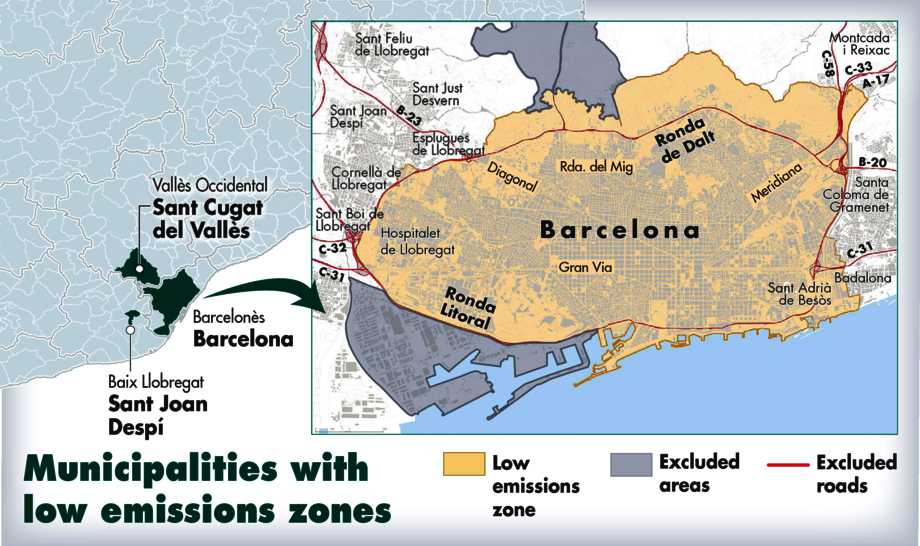More low-emission zones in Catalonia
From 2025, over 60 Catalan municipalities with over 20,000 inhabitants are committed to reducing pollution with areas that restrict traffic
One of the commitments to reduce pollution is that in two years NO2 emissions will have fallen by 15%
In order to improve air quality, the 67 Catalan municipalities with over 20,000 inhabitants will have to implement a low-emission zone (ZBE in Catalan) to limit the most polluting vehicles before the end of 2025. This was the agreement reached last month by the Catalan government, city councils, provincial councils, infrastructure managers and entities during the third summit on air quality held at the Palau de Pedralbes in Barcelona.
The decision means that Catalonia will have more ZBEs than required by Spanish law, but later than stipulated. The law on climate change requires the establishment of low-emission zones in towns with over 50,000 inhabitants by 2023 and, for those with over 20,000, only in the most polluted areas. Catalonia has decided to include all municipalities with over 20,000 inhabitants, but allowing two more years for implementation. The government’s director general of environmental quality, Marc Sanglas, noted that it is not the date that matters, because “state law does not penalise late implementation”, but the fact that municipalities that are not required to have low-emission zones are already working to have them”.
The agreement includes a commitment that by 2025 these municipalities will reduce their nitrogen dioxide (NO2) emissions by 15% from the levels registered in 2019. To help pay for the systems needed for these implementations, the Catalan government has announced a line of subsidies amounting to six million euros, which will come from the Catalan CO2 vehicle tax.
The law on climate change and energy transition defines a ZBE as a zone delimited by a public body, where restrictions on vehicle access, movement and parking are applied to improve air quality and mitigate gas emissions with greenhouse effects, in accordance with the classification of vehicles by their level of emissions.
There are three such zones in Catalonia: since January 1, 2020, the Barcelona ring roads, an area that includes Barcelona (except for the Zona Franca industrial estate and the neighbourhoods of Vallvidrera, Tibidabo and Les Planes), Sant Adrià de Besòs and Hospitalet de Llobregat, and part of Esplugues de Llobregat and Cornellà de Llobregat. At present, cars, motorbikes and mopeds, vans, lorries and small coaches that do not have the environmental badge from the Transport Directorate (DGT) are not allowed to circulate from 7 am to 8 pm between Monday and Friday. Emergency and basic services vehicles and vehicles for people with reduced mobility are exempt from these restrictions, if registered with the city council. There is also a ZBE in Sant Cugat del Vallès and Esplugues de Llobregat. In total, 95 km² of restricted traffic.
The Catalan High Court annulled the ordinance for the Barcelona low emissions zone on March 22, considering that, among other deficiencies, it was approved with a lack of preparation and reports, and an excess in the geographical scope of its application and in the type of vehicles that are excluded. This represented a win for the Platform of People Affected by Circulatory Restrictions, the Association of Large Families of Catalonia and the guilds of vehicle repair shops and transporters.
Fine air pollution caused some 307,000 premature deaths in the EU in 2019, a 10% decrease in one year, according to the European Environment Agency. By 2021, there were 280 ZBEs in 13 European states: the United Kingdom, Germany, Austria, Belgium, Denmark, Spain, France, Greece, Italy, the Netherlands, Portugal, the Czech Republic and Sweden. There are 149 municipalities in Spain with over 50,000 inhabitants that will have to implement a low-emission zone in 2023, according to Spanish law.

